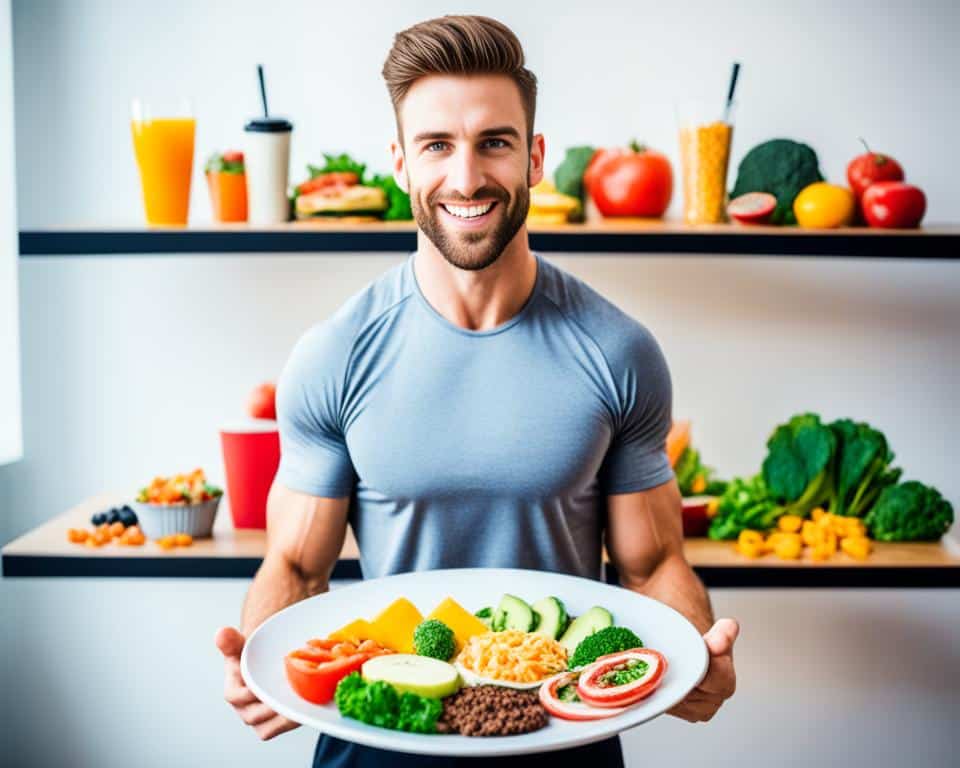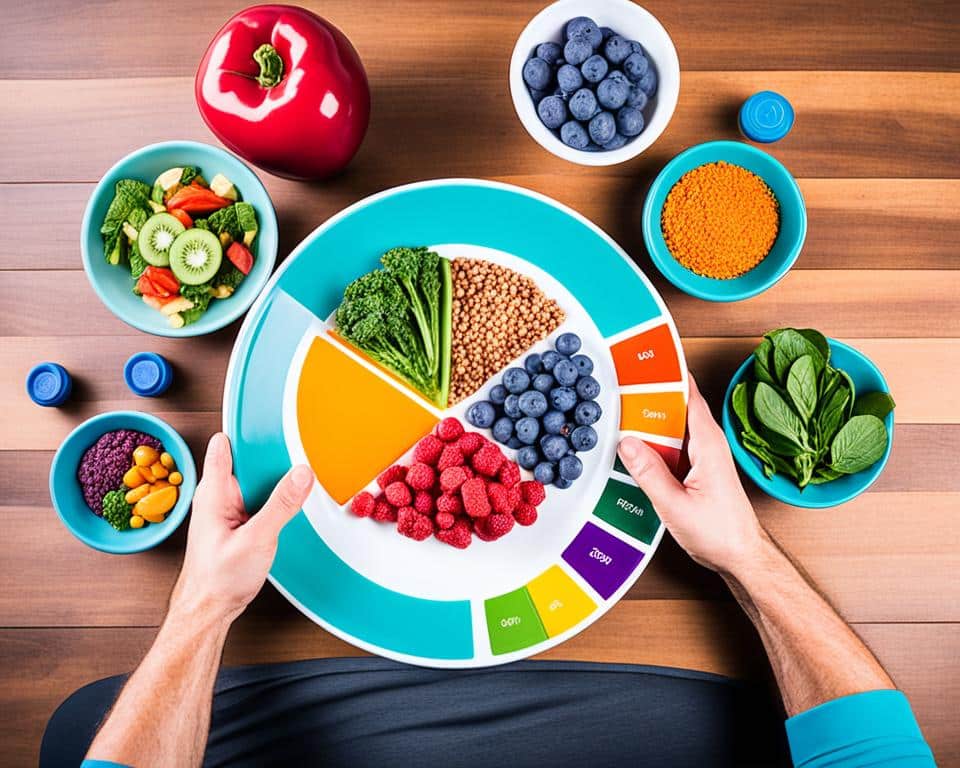
Conquering Hunger While Cutting: My Top Tips
Being a natural bodybuilder and fitness coach, I’ve had my fair share of problems when it comes to cutting while being hungry. That gnawing feeling of being hungry in the pit of my stomach that seems to be begging for just a little more food. But going for another bite isn’t always the answer. Sometimes, you need to come up with creative ways to control your hunger to keep going.
Many people in our fitness community, have been through the same thing: they tried to lose weight but were constantly hungry. It’s important to understand that hunger isn’t just a simple desire for food; it’s a complex signal that our bodies send out. If you have the willpower and the right tools, you can stay happy while cutting. It’s not just a pipe dream.
Knowing how hunger can actually help us is important. Now, let’s talk about some empowering ways to help you control your hunger and handle the cutting phase like a pro.
Key Takeaways
- Pinpointing hunger types is crucial for effective cutting.
- Implementing strategic eating patterns helps manage appetite.
- Lean proteins and high-fiber foods are key to staying full longer.
- Hunger isn’t an enemy; it’s a necessary ally in weight control.
- Consistency and willpower are essential for success in cutting phases.
Understanding Hunger During the Cutting Phase
Within the crucible of the cutting phase, my role as a fitness guide hinges on deciphering the enigma of hunger—a constant companion for those sculpting their physiques. Distinguishing the rumbles of true physical need from the whims of emotional cravings is foundational.
So is grasping that the desire for sustenance can sometimes conceal a subtler quest for psychological satisfaction.
Deciphering Hunger Signals and Managing Appetite
An understanding of hunger’s language is pivotal. Physical hunger broadcasts clear signals—a rumbling stomach and a dip in energy. Emotional hunger, while less tangible, tints our moods and stress, enticing us with comfort that food supposedly offers, though it falls beyond the realm of nourishment.
As we navigate cutting phase nutrition, staying attuned to these bodily cues propels us toward hunger management strategies that align with our fitness trajectory.
The Psychological Battle: Hedonic vs Sustenance Eating
A clash ensues within the mind between hedonism and health, a psychological tug-of-war with impulses for immediate pleasure often masquerading as hunger. The nutrition tips while cutting are straightforward—recognize the triggers, whether social settings, inadequate rest, or the allure of a buffet.
These scenarios can spur excessive eating, a temporary solace sabotaging long-term fitness aspirations. It’s a delicate balance, holding firm to dietary discipline while the senses beckon with immediate gratification.

Creating a Smart Cutting Diet Plan
I’ve learned that a successful cutting diet plan isn’t just about slashing calories—it’s about strategic eating that keeps you feeling full. Through trial and error, I’ve honed my cutting technique to balance the best foods for cutting without the hunger pangs usually tagging along.
A fundamental principle I advise my clients on is setting specific dietary rules. We calculate a daily calorie intake tailored to their goal weight and activity level, ensuring they maintain enough energy to support their workouts and day-to-day life. Then, we track every calorie using trusted apps like MyFitnessPal.
Lean protein plays a pivotal role in this equation—think grilled chicken, white fish, and plant-based options like lentils. Protein is a winner for staying satisfied while cutting. It’s the mainstay of every meal and snack, helping to ease the hunger beasts roving the stomach.
- Chicken breast
- Salmon
- Lentils
- Eggs
- Greek yogurt
Timing is also key. Smaller, more frequent meals throughout the day help keep blood sugar levels even, thwarting those all-too-common spikes in hunger. This approach requires precision: each mini-meal or snack fits into the overall daily calorie limit.
| Meal | Protein Source | Fiber Source | Healthy Fat |
|---|---|---|---|
| Breakfast | Egg whites | Oatmeal | Avocado |
| Mid-Morning Snack | Greek yogurt | Berries | Almonds |
| Lunch | Grilled chicken | Mixed greens | Olive oil dressing |
| Afternoon Snack | Protein shake | Carrot sticks | Walnut halves |
| Dinner | Steamed fish | Steamed vegetables | Coconut oil |
So, there you have it. A smart cutting diet plan is more than just what you eat—it’s how and when you eat. It’s about harnessing the nutritional power of the best foods for cutting and fine-tuning your intake schedule. That’s how you stay energized, build muscle, and drop fat—all while keeping those hunger pains at bay.
Hungry While Cutting: Combating Cravings Effectively

Let’s get real—a cutting phase can feel like a battleground, where the enemy is an unforgiving appetite. As I guide clients through their bodybuilding journeys, I’ve found that it’s not just about resisting cravings; it’s about smartly managing them.
Protein: Your Ally in Fullness
My first line of defense against being hungry while cutting? Ring the bell for protein. It’s about strategic protein intake for cutting, which keeps you full and stops those cravings in their tracks. Think of protein as your satiety sergeant, instructing your brain and stomach to work in harmony, keeping hunger at bay.
High-Fiber and High-Water Foods for Satiety
High-fiber foods and those rich in water are the unsung heroes in this fight. They bulk up your meals, pushing against the edges of your hunger without pushing the scales. Foods brimming with fiber and water are your allies, stepping in to keep your workouts fueled and your stomach quiet. Here’s my go-to list:
- Leafy greens like spinach and kale
- Crunchy carrots and cucumbers
- Hearty portions of berries
- Water-packed melons
- Fibrous lentils and beans
Incorporate these into each meal and watch your hunger run for the hills. You’ll be able to focus on what matters—sculpting the physique you’re after while combatting hunger while cutting.
Foods to Avoid While Cutting and Better Alternatives
Embarking on a cutting phase means making every calorie count for nutrient density and satiation. While tempting, high-calorie, sugar-laden foods can sabotage weight loss efforts, masking hunger rather than satisfying it. Let’s uncover the diet pitfalls to sidestep for cutting success.
What’s often overlooked in the realm of nutrition tips while cutting are the silent culprits: calorie-dense but nutritionally void snacks and meals that offer fleeting satisfaction. Their insidious nature lies not just in empty calories but in their siren call that beckons incessant nibbling, propelling us further from our goals.
Recognizing Calorie-Dense Triggers
Being aware of the foods to avoid while cutting is as crucial as knowing what to eat. Overly processed snacks, sugary beverages, and fried items not only pack in the calories but also leave you wanting more. These calorie-dense triggers can ignite cravings and sideline progress.
Substituting for Nutrient-Rich Options
Turning to the best foods for cutting, we hit the jackpot: lean proteins, complex carbohydrates, and fibrous vegetables. These nutrient-rich champions offer prolonged fullness, fueling the body and curbing hunger. Wise swaps—an art form in cutting—translate to a winning physique.
| Food to Avoid | Reason to Avoid | Better Alternative | Why It’s Better |
|---|---|---|---|
| White Bread | High GI, low fiber | Whole Grain Bread | Higher fiber, more nutrients |
| Sugary Cereal | High sugar, low nutrients | Oatmeal | Low GI, high fiber |
| Fried Foods | High in unhealthy fats | Grilled Lean Meats | Protein-rich, less fat |
| Regular Sodas | Empty calories, high sugar | Water or Herbal Tea | No calories, hydrating |
| Candy Bars | High in sugar and fat | Fresh Fruit or Nuts | Natural sugars, healthy fats |
Integrating these smart nutrition tips while cutting wields a two-pronged approach: optimizing body composition and fortifying self-discipline. The path to a leaner, healthier physique isn’t fraught with relentless hunger—if you make the right food choices. Substitution, not deprivation, is your nutritional compass for navigating the cutting landscape.
Conclusion
As we wrap up our exploration of hunger management strategies and cutting phase nutrition, it’s clear that the journey to a leaner physique is about more than just physical endurance. It’s also a mental marathon. Successfully staying satisfied while cutting isn’t merely about quieting the growling of your stomach; it’s about fostering a mindset that sees you through the long haul, transforming challenges into triumphs.
Fostering a Mindset for Long-Term Success
To secure long-term success, it’s not enough to follow a diet; you need to live it. It’s a shift from a fleeting challenge to a sustainable lifestyle. My experience in guiding others—and undergoing the process myself—teaches that true victory is found in the day-in, day-out consistency that turns regimen into routine.
Embracing Hunger as Part of the Journey
Hunger during a cut is not the enemy—it’s an inevitable truth, a companion on the road to physical betterment. Embrace it. Make peace with it. Recognize that each pang is a signal of change, an indicator you’re on the path to your goals.
With every strategy I’ve shared, from the genius of protein to the powerhouse of fiber, you’re armed to turn hunger’s daunting presence into a subtle guide toward your fittest self.
FAQ
How can I combat hunger while cutting?
To battle hunger while cutting, focus on incorporating high-protein and high-fiber foods into your diet. Frequent, smaller meals can also help manage hunger. Stay hydrated and be proactive about planning nutrient-dense meals to help keep cravings at bay.
What hunger management strategies can I use during my cutting phase?
Manage hunger by first understanding if it’s physical or emotional. Use tools such as tracking apps to monitor your intake and implement a structured meal plan. Regular exercise, sufficient sleep, and stress management techniques can also effectively control hunger.
How can I stay satisfied while following a cutting diet plan?
To stay satisfied on a cutting diet, ensure each meal includes a balance of protein, fiber, and healthy fats, which are key to feeling full. Also, choose whole foods over processed options and don’t drink your calories—opt for water or calorie-free beverages instead.
What foods are best for cutting without feeling constantly hungry?
The best foods for cutting typically include lean meats, fish, low-fat dairy products, eggs, legumes, whole grains, fruits, and vegetables. These foods not only satisfy hunger but also support muscle maintenance and overall health. The key is to choose nutrient-dense options that provide essential vitamins and minerals while keeping calorie intake in check. Understanding how to bulk and cut effectively can help you tailor your nutrition to specific fitness goals, whether you’re building muscle or shedding fat. Incorporating these balanced foods into your diet ensures long-term sustainability and better results during cutting phases.
What are the top protein sources to maintain fullness while cutting?
High-quality protein sources that are excellent for curbing hunger during a cut include chicken breast, turkey, lean beef, tofu, tempeh, fish, eggs, and low-fat dairy products like Greek yogurt and cottage cheese.
What high-fiber and high-water foods will keep me feeling full?
Foods that are high in water and fiber, which help with satiety, include vegetables like leafy greens, cucumbers, and bell peppers, fruits such as watermelon, oranges, and berries, as well as legumes, oats, and air-popped popcorn.
Can you identify common foods to avoid while cutting?
While cutting, it’s wise to limit or avoid calorie-dense foods such as sugary snacks, fried foods, full-fat dairy products, processed meats, and refined carbohydrates like white bread and pastries, which can sabotage your diet goals.
What are better dietary alternatives when trying to avoid calorie-dense triggers?
Instead of reaching for calorie-dense foods, choose nutrient-rich alternatives like fruits instead of candy, air-popped popcorn instead of chips, Greek yogurt instead of ice cream, and whole-grain options instead of refined carbs.
What mindset should I foster for long-term success in my cutting phase?
Embrace a positive mindset that acknowledges hunger as a normal part of the cutting process. Focus on the benefits of a leaner physique, better health, and improved performance rather than viewing hunger as your enemy.
How can I embrace hunger as part of my weight loss journey?
Accept that feeling hungry is an inevitable aspect of the cutting phase and use it as a signal to assess your dietary choices. Reflect on your goals, practice mindful eating, and remember that short-term hunger can lead to long-term success.



